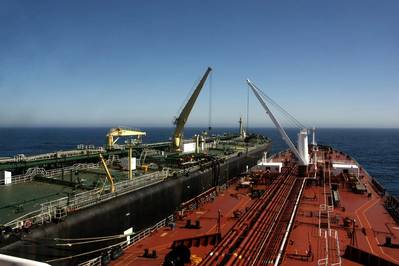Venezuela's Oil Exports Up in July, Fueled by Ship-to-ship Transfers
Venezuela's oil exports increased for the second consecutive month to 713,097 barrels per day (bpd) in July, as state-run PDVSA offset loading delays at its main port by boosting ship-to-ship transfers, according to tracking data and documents.
That was Venezuela's highest level of oil exports since February, according to the data.
A growing number of mostly unknown clients with no record in oil trading have helped PDVSA increase shipments, most of which now goes to Asia. Its traditional customers last year halted business with the company after the United States suspended exceptions to hefty trade sanctions on the state-run firm.
Amid the sanctions, the oil trade between Venezuela and China has become increasingly opaque, with many tankers that carry PDVSA's oil transferring their cargoes to other vessels off the coasts of Venezuela and Malaysia before reaching their final destination.
PDVSA shipped a total of 28 cargoes of crude and refined products last month, according to vessel tracking data and the company's exports schedules. The exported volume represented a 15.5% increase from the previous month, and 84% more than the average exported in July of 2020.
PDVSA did not immediately reply to a request for comment.
Over 80% of last month's shipments were bound for Asian destinations, including China and Malaysia. PDVSA also sent 63,400 bpd of crude and fuel to its political ally Cuba, double the volume exported in June, the data showed.
The state company struggled to ship exports from its main port of Jose last month, mainly due to very low inventories of its flagship Merey crude blend for exports, and intermittent operations for blending and upgrading the Orinoco Belt's extra heavy crude, according to the documents.
At the end of the month, three of five key crude upgrading and blending facilities operated by PDVSA and its partners were operational, one of the documents showed.
The Petromonagas joint venture, located in Venezuela's Eastern region, was getting ready to restart its upgrader this month after over a year or paralysis, while the Petrosinovensa and the Petro San Felix projects discharged over 600,000 barrels of condensate crude imported by PDVSA for using as a blending material, the document also said.
PDVSA was able to boost loadings for exports at the Amuay ship-to-ship area off Venezuela's Western coast, including an increase in shipments of residual fuel oil to Asia and the Middle East to some 275,000 bpd in July, the highest monthly average so far this year.
(Reporting by Marianna Parraga and Mircely Guanipa, Venezuela Editing by Matthew Lewis)













